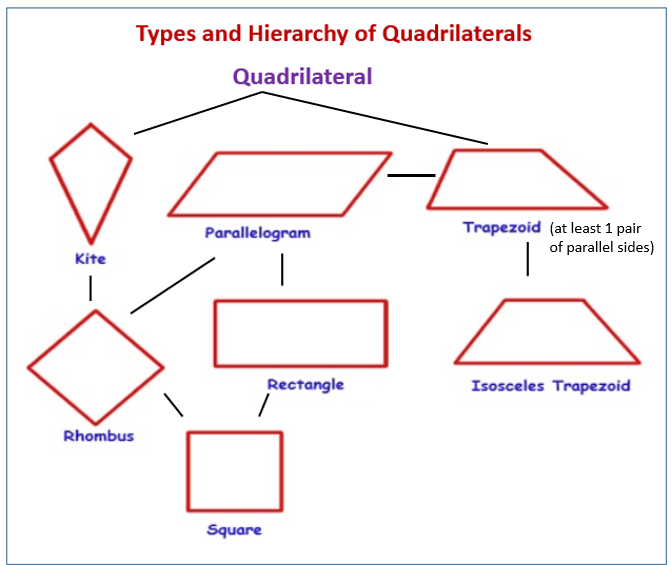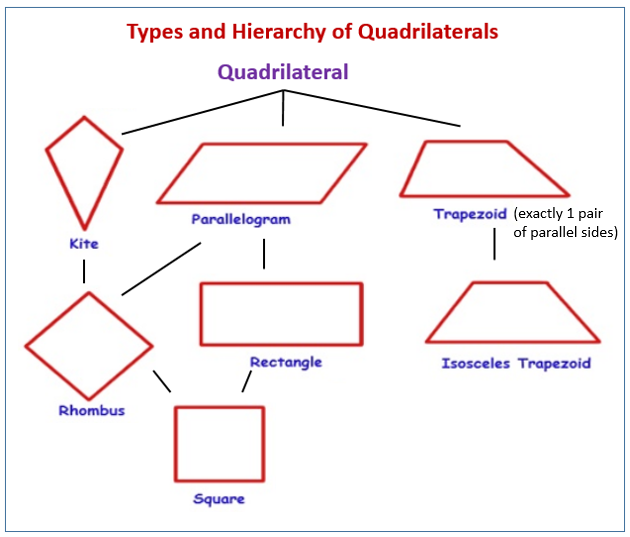Classify Quadrilaterals
These lessons help Grade 5 students learn how to classify quadrilaterals.
Related Pages
Quadrilaterals
More Lessons for Grade 5
Math Worksheets
What is a quadrilateral?
A quadrilateral is a figure with four sides and four angles. Some examples of quadrilaterals are parallelograms, rhombuses, trapezoids, rectangles and squares.
How to classify quadrilaterals?
Quadrilaterals are four-sided polygons, and there are different ways to classify them based on their properties. Here’s a breakdown of the main categories:
-
Simple Quadrilateral:
This is the most basic classification and simply refers to any four-sided closed shape.
It doesn’t have any specific properties regarding its sides or angles. -
Parallelogram:
A parallelogram has two pairs of parallel sides.
Opposite sides are parallel and equal in length.
Opposite angles are equal. -
Rectangle:
A rectangle is a special type of parallelogram.
It has all four sides at right angles (90 degrees).
Opposite sides are parallel and equal in length. -
Square:
A square is a special type of rectangle.
It has all four sides equal in length and all four angles at right angles. -
Rhombus:
All sides are equal in length, but the angles may not be right angles. -
Kite:
No parallel sides, and pairs of adjacent sides are equal. -
Trapezoid:
There are actually two accepted definitions for trapezoids, and the slight difference can cause some confusion. Here’s a breakdown of both definitions.
Inclusive Definition:
This is the more widely used definition in mathematics education.
A trapezoid is a quadrilateral with at least one pair of parallel sides.
Under this definition, a parallelogram (which has two pairs of parallel sides) is considered a special type of trapezoid.
Exclusive Definition:
This definition is less common but still used in some contexts, particularly in older geometry texts.
A trapezoid is a quadrilateral with only one pair of parallel sides.
By this definition, a parallelogram would not be considered a trapezoid.
The following diagrams shows how quadrilaterals can be classified.
In this diagram, a trapezoid is defined to be a quadrilateral that has at least 1 pair of parallel sides.

In this diagram, a trapezoid is defined to be a quadrilateral that has exactly 1 pair of parallel sides.

Classify Quadrilaterals
Learn to classify quadrilaterals: Parallelograms, Rectangles, Squares, Rhombuses and Trapezoids.
Classification of Quadrilaterals
Learn to classify quadrilaterals
Know Your Quadrilaterals Song
by Dave Nelson
Lyrics:
Are you ready to learn?
Let’s learn some geometry.
Remember polygons? That’s where we start,
They are closed shapes. They have straight sides.
The ends are together, but they don’t cross.
Pay attention and you won’t get lost.
Chorus
Quadrilaterals, they are polygons.
Quadrilaterals, have four sides.
We can classify, like a family tree.
They’re all related, and different, let’s see:
Kites, kites, in the tree by themselves.
No parallel sides, poor kites. Oh well.
They have two pair on congruent sides,
But they gotta’ touch for a kite to fly.
The diagonals cross at ninety degrees
Hey, you know Ben Franklin?
He flew one of these.
They sit in the tree on a lonely little stem.
There are no others, quite like them.
Chorus
Trapezoids are easy to tell,
One pair of sides that are parallel.
The parallel sides, why those are the bases.
In our family tree on their own oasis.
Non-parallel sides, those are the legs,
Holding up the base like two little pegs.
Take a triangle and cut off the top,
Got yourself a trapezoid. It’s not time to stop.
Ready for the rest now?
Let’s hear you sing along.
Chorus
Parallelograms have two pair of sides
That are parallel, and the same size.
They have a lot of properties that are unique.
If you knew them all, you’d be a Geo-Freak.
In the family tree, we’re at the end of the station,
Three shapes to go before your vacation.
The next three shapes are underneath the ‘gram,
That’s what makes me a great big fan.
Chorus
Our last three shapes are a type of parallelogram.
If you don’t learn them, you’ll fail the exam.
A rhombus has four equal sides.
Next to the rectangle is where it resides.
A rectangles angles are all the same,
Ninety degrees is the number, or
Right angle by name.
Put them together and say a little prayer.
Say “Hey Mom, look. I made myself a square!”
Try the free Mathway calculator and
problem solver below to practice various math topics. Try the given examples, or type in your own
problem and check your answer with the step-by-step explanations.

We welcome your feedback, comments and questions about this site or page. Please submit your feedback or enquiries via our Feedback page.